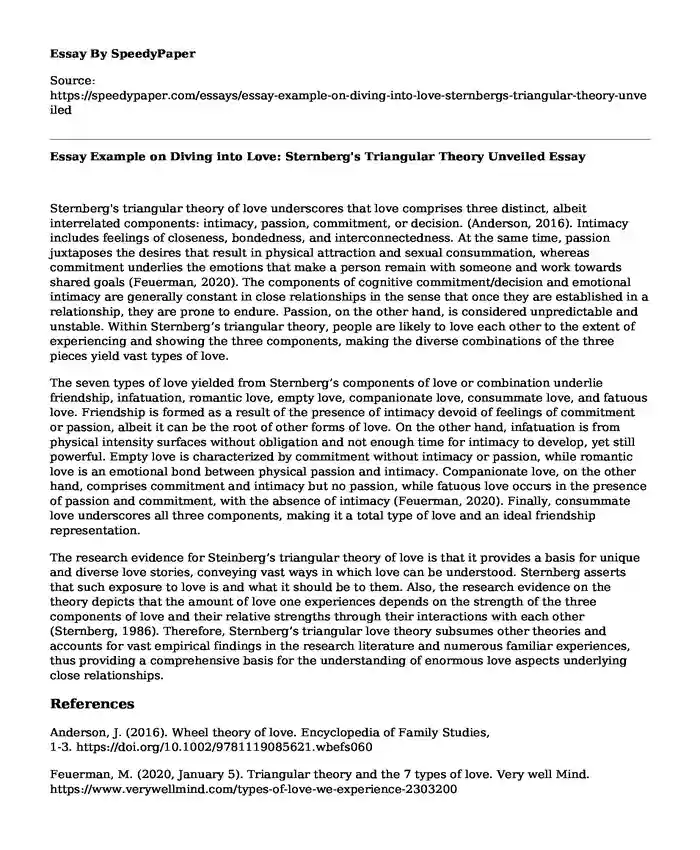
| Essay type: | Definition essays |
| Categories: | Psychology |
| Pages: | 2 |
| Wordcount: | 468 words |
Sternberg's triangular theory of love underscores that love comprises three distinct, albeit interrelated components: intimacy, passion, commitment, or decision. (Anderson, 2016). Intimacy includes feelings of closeness, bondedness, and interconnectedness. At the same time, passion juxtaposes the desires that result in physical attraction and sexual consummation, whereas commitment underlies the emotions that make a person remain with someone and work towards shared goals (Feuerman, 2020). The components of cognitive commitment/decision and emotional intimacy are generally constant in close relationships in the sense that once they are established in a relationship, they are prone to endure. Passion, on the other hand, is considered unpredictable and unstable. Within Sternberg’s triangular theory, people are likely to love each other to the extent of experiencing and showing the three components, making the diverse combinations of the three pieces yield vast types of love.
The seven types of love yielded from Sternberg’s components of love or combination underlie friendship, infatuation, romantic love, empty love, companionate love, consummate love, and fatuous love. Friendship is formed as a result of the presence of intimacy devoid of feelings of commitment or passion, albeit it can be the root of other forms of love. On the other hand, infatuation is from physical intensity surfaces without obligation and not enough time for intimacy to develop, yet still powerful. Empty love is characterized by commitment without intimacy or passion, while romantic love is an emotional bond between physical passion and intimacy. Companionate love, on the other hand, comprises commitment and intimacy but no passion, while fatuous love occurs in the presence of passion and commitment, with the absence of intimacy (Feuerman, 2020). Finally, consummate love underscores all three components, making it a total type of love and an ideal friendship representation.
The research evidence for Steinberg’s triangular theory of love is that it provides a basis for unique and diverse love stories, conveying vast ways in which love can be understood. Sternberg asserts that such exposure to love is and what it should be to them. Also, the research evidence on the theory depicts that the amount of love one experiences depends on the strength of the three components of love and their relative strengths through their interactions with each other (Sternberg, 1986). Therefore, Sternberg’s triangular love theory subsumes other theories and accounts for vast empirical findings in the research literature and numerous familiar experiences, thus providing a comprehensive basis for the understanding of enormous love aspects underlying close relationships.
References
Anderson, J. (2016). Wheel theory of love. Encyclopedia of Family Studies, 1-3. https://doi.org/10.1002/9781119085621.wbefs060
Feuerman, M. (2020, January 5). Triangular theory and the 7 types of love. Very well Mind. https://www.verywellmind.com/types-of-love-we-experience-2303200
Sternberg, J. (1986). A triangular theory of love. Psychological Review, 93(2), 119-135. https://doi.org/10.1037/0033-295x.93.2.119
Cite this page
Essay Example on Diving into Love: Sternberg's Triangular Theory Unveiled. (2023, Dec 03). Retrieved from https://speedypaper.net/essays/essay-example-on-diving-into-love-sternbergs-triangular-theory-unveiled
Request Removal
If you are the original author of this essay and no longer wish to have it published on the SpeedyPaper website, please click below to request its removal:
- Essay Example on the Stages of Psychosocial Development
- Essay Example on the Effect of Pornography on Social Relationships
- Rhetorical Analysis Essay: "Is There Pressure on Teenagers to Go to College?"
- Theories of Development. Paper Example
- Employee Performance Driven by Work Environment Motivation & Rewards - Essay Example
- John Doe's Psychodynamic Challenges - Free Essay Sample
- Paper Sample on Social Psychology: Personality, Emotion, and Motivation
Popular categories




